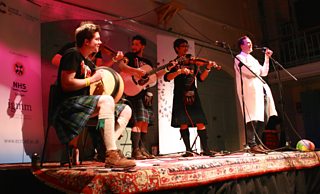Take your partners for the Science Ceilidh!
2 October 2015
For those of us who whiled away many a science period by doodling on our chemistry jotters vindication has arrived. Increasing numbers of experts are turning to creativity to help de-mystify science and in perhaps the greatest merger since McBusted we present to you Science Ceilidh.
Science Ceilidh is one of the happening this very weekend in the fair city of Edinburgh and has at its heart a group of scientist musicians who decided to take some of Scotland's best loved ceilidh dances and adapt them to explain simple science concepts.
Examples have included: the Canadian Brain Dance, the Dashing White Blood Cell, and the Orcadian Strip-the-Helix.


The Science Ceilidh has been going since April 2014, when it launched officially with the Edinburgh International Science Festival and has now played all around the UK since, seeing over 4000 dancers everywhere from Orkney Science Festival to the Greenman Folk Festival in Wales.
The founder of the Science Ceilidh Band, Lewis Hou, works as a scientist, science communicator and as a musician and noticed there was a lot of overlap between communicating science to the public and “calling” dances during ceilidhs.
"Both often are met with resistance because people aren’t confident and felt they were “not scientists” or “not dancers”. However, in both jobs, if the science concepts or dance steps are broken down clearly and approached creatively and with good humour, people can not only engage in science or the dance, but, as anyone who has been to a ceilidh can attest, enjoy them!", says Lewis.
This triggered the initial ideas, and then, being a trained Scottish Country Dancer, Lewis began adapting and writing ceilidh dances which simultaneously work as models of science concepts – from the Dashing White Blood Cell (Sergeant) to explain the Immune System to the Orcadian Strip the Helix (Willow) to demonstrate DNA replication!
The Science Ceilidh Band still also tours as a traditional Scottish music band, and here the group is visiting the island of Barra

Hou explains that as well as introducing schools to how to get creative with science, the science ceilidh band are often asked to work with real scientific researchers to help them tackle a particular field of research from a fresh perspective.
"As the idea evolved and the band got more involved, Science Ceilidhs started not only being only about the dances themselves, but like traditional ceilidhs, involve communities and researchers more creatively to develop their own new responses that can also be performed during the events, and bring people, science and music together."
Science Ceilidh Fun Palace
"Whilst last year there were over 133 Fun Palaces in the UK, only 3 were in Scotland & to spread the word of Fun Palaces here particularly, a group of volunteers from a wide range of backgrounds formed Fun Palaces Scotland, including representation from Edinburgh Beltane, Edinburgh Craft Reactor, the Science Ceilidh, Voluntary Arts Scotland, the University of Edinburgh, Textile Co-Op Kalopsia and many more", says Lewis.
The ceilidh dance they will be attemtping to devise and share this weekend is 'The Flying Photon' and has been created to help celebrate 'The Year of Light'.
If you're in Edinburgh on Sunday the Southside Community Centre Gala will offer the chance to take part in writing new ceilidh dances based on the theme of light working with folk musicians and local scientists as well as give tips on everything from learning stand-up comedy skills to the science and art of coffee.
In the evening there will be a public Fun Palace Science Ceilidh open to everybody, bringing together and showcasing performances and exhibits from the whole weekend of Edinburgh Fun Palaces.


Everyone an artist, everyone a scientist
At the heart of the campaign is the idea of arts and sciences working together - both to bring people together in local events, and also to create new work.
In 2014, 138 Fun Palaces popped up across the UK in gardens, tents, woodlands, shops, car parks, schools, theatre, arts centres, libraries, public squares, town halls, a butcher's shop and a swimming pool. All made by local people for their own communities, bringing together arts and sciences.
The Fun Palaces manifesto: "We believe in the genius in everyone, that everyone is an artist and everyone a scientist, and that arts and sciences can change the world for the better. We believe we can do this together, locally, with radical fun – and that anyone, anywhere, can make a Fun Palace."

Fighting cancer with ceilidh:

In October 2014 in part of a collaboration with Cancer Research UK in Edinburgh Science Ceilidh held a big fundraiser called the Cancer Research UK Ceilidh Experiment. For the event, the band worked with local CRUK researchers to write dances on the theme of CRUK – including the Palladium Reel (pictured in the labcoat, PhD Student Thomas Bray), Circassian Biomarker Circle (pictured here with researcher Dr Sarah Thomas) and the Antioxidant Reel – with the aim of raising both money, awareness and discussion into the work of CRUK.

A schematic of one of the science ceilidh dances:


Related Links
More from Fun Palaces
-
![]()
Unearthing Minton's blue chip history
-
![]()
Join Stella Duffy on her 11-stop library crawl in Lambeth
-
![]()
Whitstable residents re-imagine their town in miniature
-
![]()
Inviting you to be a star artsit
-
![]()
Read the six chosen poems from Fun Palaces arts and science competition
-
![]()
The weird and wonderful world of microscopic art






